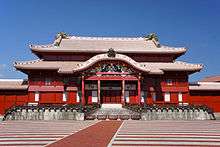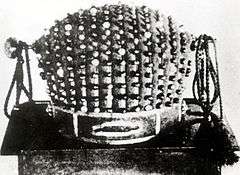List of monarchs of Ryukyu Islands
| King of Ryūkyū | |
|---|---|
 | |
|
Crown of the King of Ryūkyū | |
| Details | |
| Style | Your Majesty (首里天加那志) |
| First monarch | Shunten |
| Last monarch | Shō Tai |
| Formation | 1429 |
| Abolition | March 17, 1879 |
| Residence | Shuri Castle |
| Pretender(s) | Mamoru Shō |
The list of monarchs of the Ryūkyū Islands extends from King Shunten in the 12th century through the last king in the 19th century.
| History of Ryukyu | ||||||||||||||||||||||||||||||||||||||||||||||||
|---|---|---|---|---|---|---|---|---|---|---|---|---|---|---|---|---|---|---|---|---|---|---|---|---|---|---|---|---|---|---|---|---|---|---|---|---|---|---|---|---|---|---|---|---|---|---|---|---|
 | ||||||||||||||||||||||||||||||||||||||||||||||||
|
Periods
|
||||||||||||||||||||||||||||||||||||||||||||||||
|
Topics
|
||||||||||||||||||||||||||||||||||||||||||||||||
Tenson Dynasty
According to the "Mirror of Chūzan" (中山世鑑, chūzan seikan), the founder of the Tenson Dynasty (天孫王朝) was a descendant of Amamikyu (阿摩美久, the goddess of creation in the Ryukyuan religion). Though the "Mirror of Chūzan" said that the Tenson Dynasty had 25 early kings, the names of the other kings are still unknown.
Shunten Dynasty
In 1186, the 25th king's throne was usurped by Riyū (利勇). Shunten overthrew Riyū the next year, becoming king of the Ryūkyū Islands. He established the Shunten Dynasty.
| Name | Hanzi/Kanji | Mikoto | Reign | Age at death |
| Shunten | 舜天 | Mikotoatsushi 尊敦 |
1187–1237 | 71 |
| Shunbajunki | 舜馬順熙/舜馬順熈 | Kiekimi 其益美 |
1238–1248 | 63 |
| Gihon | 義本 | None | 1249–1259 | ? |
Eiso Dynasty
In 1259, Gihon, who was the last king of Shunten Dynasty, abdicated his throne. His Sessei Eiso succeeded him.
| Name | Hanzi | Mikoto | Reign | Age at death |
| Eiso (Ryukyu) | 英祖 | Ezo no tedako 英祖日子 |
1260–1299 | 70 |
| Taisei | 大成 | Unknown | 1300–1308 | 9 or 61 |
| Eiji | 英慈 | Unknown | 1309–1313 | 45 |
| Tamagusuku | 玉城 | Unknown | 1314–1336 | 40 |
| Seii | 西威 | Unknown | 1337–1354 | 21 |
Sanzan period
The Sanzan Period is a period of history of the Ryūkyū Kingdom that lasted from 1322 until 1429. During these years, the island of Okinawa was politically divided into three kingdoms.
- Satto Line
(Chūzan Kingdom, 1355–1406)
Chūzan Kingdom had paid tribute to Ming court in 1372 and 1404.
| Name | Hanzi | Mikoto | Reign | Age at death |
| Satto | 察度 | Ufu mamono 大真物 |
1355–1397 | 74 |
| Bunei | 武寧 | Naga no mamono 中之真物 |
1398–1406 | 50 |
- Ōsato Line
(Nanzan Kingdom, 1337–1429)
Nanzan Kingdom had paid tribute to Ming court in 1383 and 1388.
| Name | Hanzi/Kanji | Mikoto | Reign | Age at death |
| Ufusatu | 承察度 | None | 1337–1396 | ? |
| Oueishi | 汪英紫 | None | 1388–1402 | ? |
| Ououso | 汪應祖/汪応祖 | None | 1403–1413 | ? |
| Tafuchi | 達勃期 | None | 1413–1414 | ? |
| Taromai | 他魯每 | None | 1415–1429 | ? |
- Haniji Line
(Hokuzan Kingdom, 1322–1416)
Hokuzan Kingdom had paid tribute to Ming court in 1383.
| Name | Hanzi | Mikoto | Reign | Age at death |
| Haniji | 怕尼芝 | None | 1322–1395 | ? |
| Min | 珉 | None | 1396–1400 | ? |
| Hananchi | 攀安知 | None | 1401–1416 | ? |
The First Shō Dynasty
(Chūzan Kingdom, 1407–1429;
Ryūkyū Kingdom, 1429–1469)
In 1406, Bunei was overthrown and Shō Shishō became the nominal king of Chūzan Kingdom, placed there by his eldest son Shō Hashi as part of a power bid to control Chūzan while giving an appearance to China of proper Confucian respect for one's elders. Hashi then set out to conquer the island, conquering the other aji (tribal lords) of Chuzan and then, in 1416, the northern kingdom, Hokuzan. In 1421, after the death of his father, Shō Hashi became the ruler of Chuzan and claimed to China that he had unified the island of Okinawa and asked to be recognized as the king (although he had not, in fact, yet conquered the entire island; Nanzan, the southernmost kingdom, remained independent until 1429). Thus, in 1422, the Hongwu Emperor recognized Hashi as king, gave Hashi the surname Shō (尚) as the designator for his dynasty, and gave a new name to the country: Ryūkyū Kingdom.[1]
| Name | Hanzi/Kanji | Mikoto | Reign | Age at death |
| Shō Shishō | 尚思紹 | Kimishi mamono 君志真物 |
1407–1421 | 67 |
| Shō Hashi | 尚巴志 | Sejitaka mamono 勢治高真物 |
1422–1439 | 67 |
| Shō Chū | 尚忠 | Unknown | 1440–1442 | 54 |
| Shō Shitatsu | 尚思達 | Kimiteda 君日 |
1443–1449 | 41 |
| Shō Kinpuku | 尚金福 | Kimishi 君志 |
1450–1453 | 55 |
| Shō Taikyū | 尚泰久 | Nanojiyomoi 那之志與茂伊 also called "ōyononushi" 大世主 |
1454–1460 | 45 |
| Shō Toku | 尚德/尚徳 | Hachiman aji 八幡按司 also called "Sekōkimi" 世高王 |
1461–1469 | 29 |
The Second Shō Dynasty
(Ryūkyū Kingdom (琉球王國), 1470–1872; Ryūkyū Domain (琉球藩) of Japan, 1872–1879)
In 1469, Shō Toku, the last king of The First Shō Dynasty, was killed in a coup d'état with no son to succeed. So courtiers elected Shō En as king, and established The Second Shō Dynasty.
During King Shō Shin's reign, the Ryūkyū Kingdom was rich, powerful and prosperous, conquering the Sakishima Islands and centralizing the royal government. It was called "the Great Days of Chūzan", a "golden period" in Ryūkyūan history. But the military strength of the Ryukyu Kingdom soon declined after his death, although later kings made gains against the Satsuma Domain of Japan in conquering the Amami Islands. In 1609, Satsuma Domain invaded the Ryukyu Kingdom, capturing the Amami Islands and landing on Okinawa Island. After taking Nakijin Castle, Urasoe Castle, and Shuri Castle, King Shō Nei was taken as a prisoner to Kagoshima and later to Edo (modern day Tokyo). The king was forced to sign an oath of vassalage to the head of Satsuma Domain. From then on, Ryukyu was a vassal state of Satsuma; the king had to pay tribute to both China and Satsuma.
The Ryukyu Kingdom became a Han of Japan in 1872.
In 1879, Japan replaced Ryūkyū Domain with Okinawa Prefecture, formally annexing the islands. King Shō Tai was dethroned and given the title of marquis and removed to Tokyo.
| Name | Hanzi/Kanji | Mikoto | Reign | Age at death |
| Shō En | 尚圓/尚円 | Kanamaru aji suetsugi no ōnishi 金丸按司添末續之王仁子 or "Kanamaru ajisohi" 金丸按司添 |
1470–1476 | 61 |
| Shō Sen'i | 尚宣威 | Iri no yononushi 西之世主 |
1477 | 48 |
| Shō Shin | 尚真 | Okiyakamowe 於義也嘉茂慧 |
1477–1526 | 61 |
| Shō Sei | 尚清 | Tenzoku no ajisohi 天續之按司添 |
1527–1555 | 59 |
| Shō Gen | 尚元 | Tedaji ajisohi 日始按司添 |
1556–1572 | 44 |
| Shō Ei | 尚永 | Ezoniyasohi ajisohi 英祖仁耶添按司添 also called "Tedayutamisaokimi" 日豐操王 |
1573–1586 | 30 |
| Shō Nei | 尚寧 | Megama ajisohi 日賀末按司添 |
1587–1620 | 56 |
| Shō Hō | 尚豐/尚豊 | Tenkiyama ajisohi 天喜也末按司添 |
1621–1640 | 50 |
| Shō Ken | 尚賢 | 1641–1647 | 23 | |
| Shō Shitsu | 尚質 | 1648–1668 | 39 | |
| Shō Tei | 尚貞 | 1669–1709 | 64 | |
| Shō Eki | 尚益 | 1710–1712 | 34 | |
| Shō Kei | 尚敬 | 1713–1751 | 52 | |
| Shō Boku | 尚穆 | 1752–1795 | 55 | |
| Shō On | 尚溫/尚温 | 1796–1802 | 18 | |
| Shō Sei | 尚成 | 1803 | 3 | |
| Shō Kō | 尚灝 | 1804–1828 | 47 | |
| Shō Iku | 尚育 | 1829–1847 | 34 | |
| Shō Tai | 尚泰 | 1848–1879 | 58 |
See also
Notes
- ↑ Kerr, George. Okinawa: The History of an Island People. Tokyo: Tuttle, 2000. p. 89.
References
- Kerr, George H. (1965). Okinawa, the History of an Island People. Rutland, Vermont: C.E. Tuttle Co. OCLC 39242121
